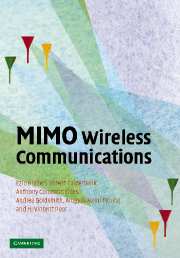Book contents
2 - Capacity limits of MIMO systems
Published online by Cambridge University Press: 15 December 2009
Summary
Introduction
Chapter 1 introduced the basic concepts behind multiple-input multiple-output (MIMO) communications along with their performance advantages. In particular, we saw that MIMO systems provide tremendous capacity gains, which has spurred significant activity to develop transmitter and receiver techniques that realize these capacity benefits and exploit diversitymultiplexing trade-offs. In this chapter we will explore in more detail the Shannon capacity limits of single- and multi-user MIMO systems. These fundamental limits dictate the maximum data rates that can be transmitted over the MIMO channel to one or more users (not in outage) with asymptotically small error probability, assuming no constraints on the delay or the complexity of the encoder and decoder. Much of the initial excitement about MIMO systems was due to pioneering work by Foschini and Telatar predicting remarkable capacity growth for wireless systems with multiple antennas when the channel exhibits rich scattering and its variations can be accurately tracked. This promise of exceptional spectral efficiency almost “for free,” also studied in earlier work by Winters, resulted in an explosion of research and commercial activity to characterize the theoretical and practical issues associated with MIMO systems. However, these predictions are based on somewhat unrealistic assumptions about the underlying time-varying channel model and how well it can be tracked at the receiver as well as at the transmitter. More realistic assumptions can dramatically impact the potential capacity gains of MIMO techniques. This chapter provides a comprehensive summary of MIMO Shannon capacity for both single- and multi-user systems with and without fading under different assumptions about what is known at the transmitter(s) and receiver(s).
Information
- Type
- Chapter
- Information
- MIMO Wireless Communications , pp. 24 - 87Publisher: Cambridge University PressPrint publication year: 2007
